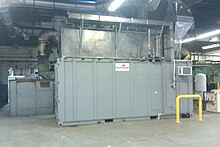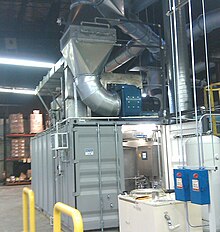User:Randy Glad/sandbox
Biological Oxidizer[edit]
What is a Biological Oxidizer?[edit]
Biological processes have found little use in the treatment of potable water supplies because of the low level of biodegradable organics in the raw water. However, biological processes are used extensively in treating wastewater and Volitile Organic Compounds produced from different commericial or industrial operations to convert biodegradable organics and other nutrients into a more manageable form. Biological oxidation is natural process and is so different from the triditional chemical oxidizing agents used to reduced various compounds. Some of the more commonly used micro-organisms are namely Bacillus, Cocus, Sprillum as well as heterotrophy bacteria which play an important role in biological degradation. Generally these micro-organisms are rod shaped facultative bacteria which perform the degradation task very well. Bioremediation methods are incorporated with advanced equipment and are associated with organism’s natural ability to oxidize and stabilize a large number of organics which that include), heterocyclic compounds (such as quinoline or pyridine ), polyaromatichydrocarbons (PAHs) pharmaceutical substances, polychlorinated biphenyls, radionuclides, Hydrocarbons (oil), (BETEX) toluene, benzene, xylene sand ethyl-benzene , (MEK) Methyl-ethyl ketone and few metals.

The prompt removal of varieties of wide range of wastes and pollutants from the environment is foremost requisite to safeguard the environment with increasing sustainable development which leads to minimal negative environmental impact ultimately. Taking benefits from microorganism excellent anabolism and catabolism adaptability to degrade and finally produce stabilized matters from contaminants the bioremediation process takes place and organic matters are removed. As all kind of micro-organism are not equally effective in oxidizing organic matter so their genetic evolution, sequencing and imaging as well as their favorable environment for better growth are very important to know. In the mean time, it is known that microbiology is providing significant views of regulatory and metabolic pathways as well as effectiveness to molecular adaption and biological degradation in our changing environment. A pragmatic genetic approach is enhancing our identification of different pathways and ability to carbon exchange in certain industrial environment clearly. This genetic study will bring revolutionary change in biological oxidation process in near future.
Alleviation mechanism of toxic and hazardous air pollutants as well as Volatile Organic Carbon from the Air[edit]
Micro-organisms are utilized in biological remediation to control air pollution in industrial and commercial effluents and emissions. In this system of remediation air is passed through a packed bed having thin biological film at the surface of packing media and as the pollutant transfer into this bio-film then they are trapped by gelatinous bio-layer by interception, filtration, flocks and sweep. The attached growth micro-organism are immobilized into the thin biological film and thus different easily biodegradable organic matters are stabilized or oxidized.

As biological film accomplishes this degradation so recirculation of waste water leads to more growth of attached film thus increase efficiency to the filter. This biological treatment process has excellent application in treating Volatile Organic Compounds (VOCs), BTEX, water based paints and malodorous material. Also in case of foam, automobile, food and chemical, painting wooden furniture and styrene, the biological technology is being used to a large extent. VOCs and various compounds of Sulfur such as Hydrogen sulfide (H2S) and various odor producing gases are treated using this technology. Large surface area and footprint are required to treat huge amount of influent waste water and now a days more advanced biological oxidation equipment is available with a much smaller footprint but occupying same area as previous thermal oxidizer. Excessive formation of bio-film leads to certain problem such as sloughing so maintaining optimum biological treatment is very important. This task is accomplished by maintaining proper moisture content. For this purpose the humidity of the air is adjusted by humidification chamber before it flows over the packing media then it enters into biological tower, trickling filter and scrubber. The packing media may be natural or made of synthetic plastic media which are very popular now a days. Among them synthetic packing media works properly for more than 10 years. Many companies produce different packing media commercially to be used for this biological technology. One may also prepare a natural bed made of wood chips or gravel and stone.
Benefits and efficiency of Biological Oxidizer[edit]
As mentioned above the technology of using microorganism in oxidizing organic matters has led to the innovation for low cost secondary treatment of the waste water and air. The process of stabilization of biodegradable matters are very fast even when the influent has a high concentration of organic matters. It also destroys soluble and non-soluble paints at efficiency of greater than 98%. This technology is free from secondary contamination as in the case of incineration which potentially produces CO, CO2, NO2 and SO2.

Recirculation of water is always completed in the biological oxidation system to make the system cost-effective. Biochemical oxygen Demand (BOD) indirectly measures the amount of easily biodegradable organic matters thus very low values indicate direct disposal and this value is generally less than 40 mg/l.
For its lot of advantages biological treatment technology is spreading worldwide day by day and it is considered the most low cost form of secondary treatment. There are some new advanced technologies besides biological treatment but they are highly costly. That is why it is being used to reduce amount of pollutants in developed countries such as Germany, Columbia, Japan and more recently the United States of America.
External Links[edit]
Notes:[edit]
1. Howard S. Peavy and et al:Environmental Engineering,Mc Graw-Hill,Newyork,1985
2. Monod,J:The Growth of Bacterial Cultures,Ann Ret Microbiology,vol.3,1949
3. Wong-Chong ,G M and R.C Loehr:The Kinetics of Microbial Nitrification,Water research,9,175

